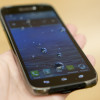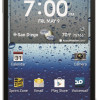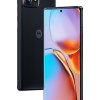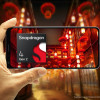Review: Kyocera Hydro Vibe for Sprint
Screen
In order to maintain its compact dimensions, Kyocera gave the Hydro Vibe a 4.5-inch screen with 960 x 540 pixels - or qHD resolution. Kyocera picked this display to help keep the cost of the Vibe down. Larger, higher-resolution screens would also impact battery life and processor performance. It's a decent screen and does well enough for this class of device. It's not the sharpest display ever created and on-screen elements occasionally revealed some pixels along the edges. I found the display to be very bright and I had no trouble using it outdoors as a camera. Colors are accurate, and there's no color shift or brightness drop off when the phone is tilted side-to-side. The Vibe has a nice little display.
Signal
The Vibe performed on par with other devices I've tested on Sprint's network in the metro NYC area. It always held onto at least a little bit of signal. In weak coverage areas the Vibe was able to make phone calls (though it often took more than one try), and couldn't load a web page to save its life (see screenshots). In stronger coverage areas, the Vibe did well in terms of both voice and data performance. LTE speeds were decent for Sprint, but they don't compare to what's available with AT&T, T-Mobile, or Verizon's networks.
Sound
The Vibe uses Kyocera's Smart Sonic Receiver technology. You'll notice the Vibe doesn't have a traditional earpiece speaker at all. The technology eliminates the need for a speaker and instead uses vibrations to transmit sounds directly to the eardrum. Placing the phone in contact with the general area of the ear is supposed to create clear sound even in very noisy environments. This tech works automatically; you don't have to do anything to enable it. If you're wearing a helmet, just press the Vibe against the helmet and you should be able to hear calls.
In the Vibe's case, I struggled a bit to hear calls in my quiet office even when the volume was set all the way up. I found if I pressed the phone very hard against my head - almost to the point of causing pain - I could hear better. Paradoxically, the Vibe was easier to hear in noisy environments. I didn't have any trouble maintaining a conversation in a noisy car, for example (don't worry, I wasn't driving). I also tested the Vibe when wearing a helmet. It's amazing just how well it works through plastic. Quality of these calls was average.
You can also choose to pass calls to the speakerphone, which is a traditional speaker placed on the back of the phone. The quality of calls sent to the speakerphone were average at best, and sometimes below average. The quality was scratchy at times, and the volume just barely adequate when set all the way up. I found the ringers and alerts were decent for most environments. The vibrate alert produces a good buzz.
Battery
The Vibe delivered much better battery life than some of Kyocera's other Android smartphones. I easily managed to get a full day's use with moderate email, social network, browsing, and media consumption. The Vibe includes Kyocera's MaxiMZR and Eco Mode tools to help you further improve battery life; they do help.
MaxiMZR analyzes the data usage and can limit the background data consumption of certain apps (such as email or Facebook) to help conserve power. The tool takes at least a few days to learn how you use your apps. Eco Mode helps refine the Vibe's power consumption by shutting down predetermined services once the battery reaches a predetermined percentage. For example, Eco Mode could be used to turn off automatic email fetch once the battery drops below 20%.
Most people shouldn't need these tools to get through a full day.






 Hands On with the Kyocera Hydro Icon
Hands On with the Kyocera Hydro Icon
 Sprint and Virgin to Sell Kyocera Hydro Vibe
Sprint and Virgin to Sell Kyocera Hydro Vibe
 Motorola's New Flagship Gets its Signature Edge Back
Motorola's New Flagship Gets its Signature Edge Back
 Qualcomm's New Chip for Entry-Level Phones Moves to 4nm
Qualcomm's New Chip for Entry-Level Phones Moves to 4nm
 Kyocera Hydro Vibe / Icon
Kyocera Hydro Vibe / Icon




